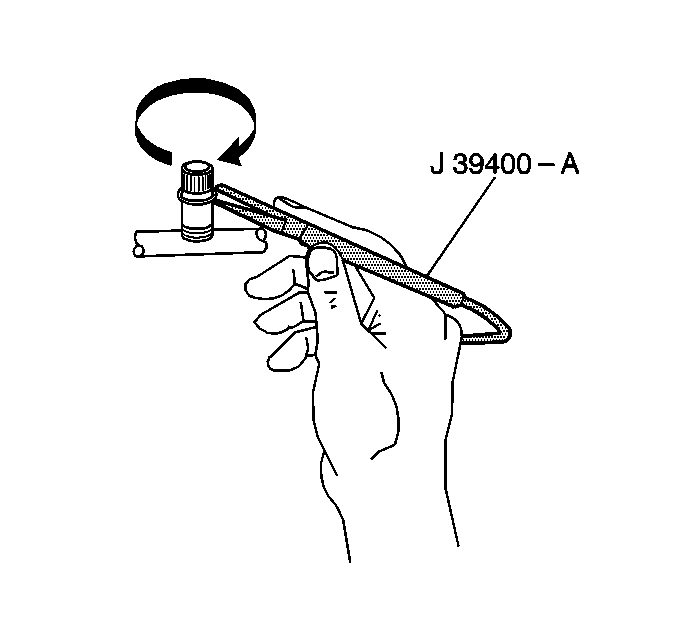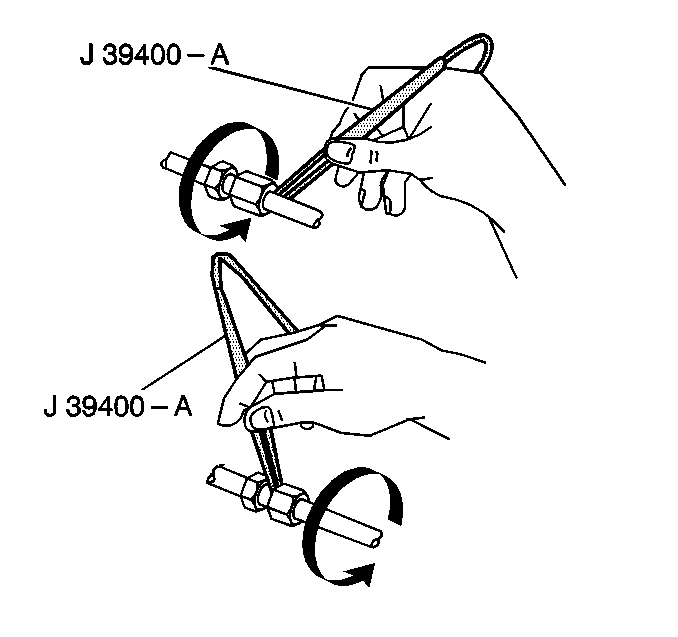Important: Vehicles equipped with an early warning system for LOW REFRIGERANT may set the LOW REFRIGERANT codes.
Perform a refrigerant leak test on the system whenever you suspect a leak. Perform a refrigerant leak test on the system following a service operation that disturbs the components, the lines, or the connections. Many methods and special tools are available for this purpose. However, no matter which tool you use, care and diligence are the biggest keys to success.
Electronic Leak Detector
Tools Required
J 39400 Kent-Moore Leak Detector
Caution: Do not operate the detector in a combustible atmosphere since its sensor operates at high temperatures or personal injury and/or damage to the equipment may result.
Important:
• The halogen leak detectors are sensitive to windshield washing
solutions, many solvents and cleaners, and some adhesives used in the vehicle.
Prevent a false warning by making sure the surfaces are clean. Also, the
surfaces should be dry, because the ingesting liquids damages the detector.
Use this procedure in order to test the following components: • The low side sensors • The high side sensors • The transducers • The switches • The evaporator inlet and outlet • The accumulator dryer inlet and outlet • The condenser inlet and outlet • The other connections • All of the brazed and welded areas • All of the areas with apparent damage • The hose couplings • The compressor rear head • The housing joints • Follow the refrigerant system in a continuous path so that you
do not miss any areas of potential leaks. Test every area listed above in
order to assure that the entire system is leak-free, even after finding
a leak.
The electronic detector type of leak detector is the most useful tool in locating refrigerant leaks. The J 39400 is a small unit that operates on 12V DC. The J 39400 provides an audible signal that increases in frequency as R-134a is detected. The detector has three settings:
| • | R-12 |
| • | R134a |
| • | Gross |
The gross leak setting isolates very large leaks located by using one of the other 2 settings. Properly calibrate the instrument in accordance with the included instructions. Use the detector in the proper setting for the type of refrigerant being tested. Prior to beginning the test, make sure the refrigerant system has a sufficient charge by measuring the static pressure with a gauge set. Readings in the range of 413.7-689.5 kPa (60-100 psi) are acceptable for leak testing.

The most common leaks are found at the refrigerant fittings or connections. The following conditions may cause leaks:
| • | Improper torque |
| • | Damaged O-ring seals |
| • | Lack of O-ring seal lubrication |
| • | Dirt and debris across the O-ring seals |

The successful use of this or any other electronic leak detector depends greatly upon the scan rate. The successful use of the detector depends upon carefully following the manufacturer's instructions regarding calibration, operation, and maintenance. Circle each joint completely. Move the probe at 25-51 mm (1-2 in) per second. Move the tip of the probe as close to the surface as possible, but no more than 6 mm (0.25 in) away. Do not block the air intake. The audible tone changing from a steady 1-2 clicks per second to an a solid alarm indicates a leak. Frequently adjust the balance knob in order to maintain the rate of 1-2 clicks per second.
Service Ports/Access Valves
The primary seal for the service ports is the sealing cap. This cap contains a specially designed O-ring seal or gasket that provides a leak-free seal. A loose or missing cap, or using the wrong cap, results in the loss of the refrigerant charge.
Evaporator Core
Finding leaks in the evaporator core is one of the most difficult tasks in detecting leaks. In order to leak test the core, complete the following steps:
- Turn the blower fan to the high position for 15 seconds or longer.
- Wait 10 minutes.
- If the blower fan power module or resistor block is accessible, remove the module.
- If the blower fan power module or resistor block is not accessible, inspect the condenser drain tube for moisture.
- Insert the probe of the leak detector into the power module/resistor block opening or the condenser drain tube.
- If possible, visually inspect with a flashlight the core face for the evidence of refrigerant oil.
Then, turn the blower fan to the OFF position.
If the condenser drain tube is dry, use the drain tube in conducting the test.
A solid alarm indicates a leak.
On R-134a systems, the lubricant is water soluble, so evidence of oil is unlikely, even with a leak.
Compressor Shaft Seal
- Blow shop air behind and in front of the compressor clutch/puller for at least 15 seconds.
- Wait 1-2 minutes.
- Probe the area in front of the pulley.
A solid alarm indicates a leak.
Liquid Leak Detectors and Pressure Testing
Due to restricted visibility and a lack of sensitivity in today's refrigerant systems, the usefulness of liquid/bubble leak detectors is very limited.
